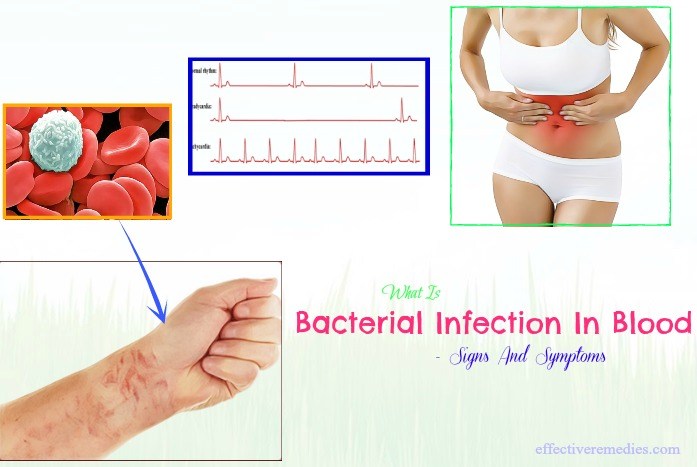Contents
Overview
When diagnosed very early, a bacterial infection in blood in the early stage can be treated with antibiotics. Researchers are focused on seeking best ways to diagnose this condition. Therefore, knowing the definition of bacterial infection as well as its causes and symptoms is very important. Today, Effective Remedies will show you what is bacterial infection in blood in early stage and some basic information on this disease, including its causes, symptoms, & prevention.
- 47 natural home remedies for bacterial infections on skin, in ear, mouth, stomach, vagina, & blood
- What is low blood pressure – causes, symptoms, treatment, & prevention
What Is Bacterial Infection In Blood In Early Stage? – Causes, Symptoms, & Prevention
I. What Is Bacterial Infection In Blood In Early Stage?
The coming information is effective for the infection in the blood of early stage of the condition. It is highly recommended that you take advice and treatment from the doctor, aside from using these methods.
Sepsis is an acute infection caused by bacteria circulating in the blood. They cause a variety of clinical symptoms, including multiple organ transplants and septic shocks with very high mortality rates ranging from 20 to 50% of cases. And septic shock is a serious symptom of sepsis.
Septicemia is a serious infection, a disease that is not localized to an early lesion, but through the bloodstream. Many causes are leading to sepsis such as severe initial damage, no prompt treatment or virulence of too strong microorganisms.
II. What Is Bacterial Infection In Blood – Signs And Symptoms
Common signs and symptoms of the disease include:
EffectiveRemedies Partner Solutions

Ask a Doctor Online and Get Answers in Minutes, Anytime!
Have medical questions? Keep asking questions to a Verified Expert until you get the answer you need.
· Temperatures above 38 0C or below 36 0C
· Tachycardia over 90 beats/min
· The rhythm is rapid at 20 beats per minute
Severe sepsis cases will have signs and symptoms such as:
· Average urine output dropped sharply
· Mental illness is unstable
· Reduced platelet count
· Shortness of breath
· Arrhythmia
· Abdominal pain
· Infection shock
III. What Is Bacterial Infection In Blood – Causes
In fact, many risk factors can lead to sepsis, including:
- elderly people
- infants
- premature babies
- people who take immunosuppressive drugs, prolonged steroids, drugs anti-rejection
- treatment of chemicals and radiation
- people with chronic diseases such as diabetes, HIV/AIDS, cirrhosis, heart valve disease and congenital heart disease, chronic lung disease, chronic kidney failure
- patients with splenectomy, alcoholism, blood disease, malignant granuloma
- patients using intrathecal devices or devices such as nailing internal nails, placing ducts, placing endotracheal tubes.
The cause of bacterial septicemia is the direct entry into the bloodstream of the bacteria or from infections in the tissues of tissues, such as the skin, soft tissues, muscles, bones, joints, respiratory and digestive tract. Common bacteria that cause sepsis include gram-negative bacteria, gram-positive bacteria, and anaerobic bacteria. Gram-negative bacteria are mainly Enterobacteriaceae such as Salmonella, Escherichia coli, Klebsiella, Serratia and Enterobacter bacteria, Pseudomonas aeruginosa, Burkholderia pseudomallei, etc. Gram-positive bacteria are Streptococcus types of pneumonia, Staphylococcus aureus, Streptococcus suis, etc. Common anaerobic bacteria are Clostridium perfringens and Bacteroides fragilis.
IV. What Is Bacterial Infection In Blood – Prevention
1. Hand Cleaning
Hand hygiene is the most important measure in preventing infections because hands are an important means of spreading infectious agents that have been studied extensively and are no longer a matter of debate. Studies also show that hand-washing process is not done properly. People often put the blame on busy works, or they aren't aware of the importance of washing their hands. In the world, the incidence of infection is high. On the hands, there are both kinds of bacteria, including resident bacteria and transmitting bacteria. Resident bacteria are less likely to cause infections through normal contact, but they can be toxic through invasive procedures. Transmitting bacteria are common carriers of severe bacterial infection, which usually last for up to 28 hours.
How to do:
· Prepare clean water, preferably hot water, and soap solution.
· Remove jewelry on the hands. Cut the nail if it is long. Roll sleeves up over elbows.
· Open water with elbows or legs. Keep your hands and arms lower than the elbows.
· Take about 3 – 5ml of hand-washing liquid into your palm. Rub palms together.
· Use the palm of this hand rubbing the back of the hand and the fingers of the other hand and vice versa.
· The palms are rubbed together and intertwined in the fingers.
· Rub these fingers against the palm of the other hand and vice versa.
· The finger of this hand rubs in the other hand by turning and twisting.
· Pinch five fingers of this hand and rub on the palm of the other hand by rotating then vice versa.
· Rinse soap in the hands under running water.
· Close the tap on your elbows with a towel. Put the towel in place
· Dry your hands with a clean towel or paper or dryer, wipe from forefinger first to your hands and wrists.
2. Clean your items which are often touched at home and in the office. You can reduce the number of bacteria in the environment by keeping your items clean.
3. Avoid people who look like sick. You cannot know someone who has just had a cold or something more serious. So it's best to avoid getting too close to someone who looks like sick.
4. Avoid touching people you know they have infections, flu, or who tell you they have an infection.
Note: Sometimes water and food can be contaminated, so you need to listen to information to avoid contaminated food and water.
5. Keep your hands clean when preparing food. Hand-washing is an important step in preventing infections inside and outside the kitchen. You should wash your hands before and after handling the food. It is important to rinse your hands thoroughly after going to the bathroom and changing diapers, and before you start cooking.
V. What Is Bacterial Infection In Blood – When To See A Doctor?
Make an appointment with your doctor or surgeon as soon as you feel the above symptoms, your pain increases or the pain gets worse. The professional medical treatment will have proper tests and X-rays test, and blood tests to define the reasons for your condition and consult you the best advice. Do not let your condition untreated.
If you want to read more other such articles, you can go to our main News & Facts. If you have any problems or questions about the topic “what is bacterial infection in blood in early stage and its causes, symptoms, & prevention”, please leave your comments at the bottom of this article.










